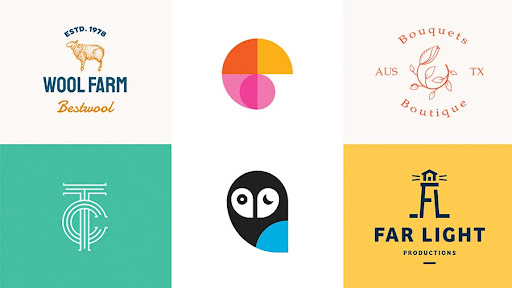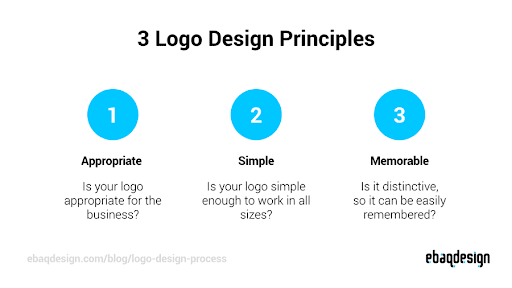Have you ever noticed how some small business logos like Warby Parker catch your eye? It’s not just about the design – it’s the principles behind it that make all the difference. Your logo is essentially the face of your company and it’s often the first thing potential customers see. This is why it’s important to follow logo design best practices and trends to accurately represent your brand and keep up with current design standards.
To create a killer logo for your small business, you should choose the right colors to ensure scalability. These principles will help you create a logo that not only looks great but truly reflects your brand’s personality and values.
In this article, we’ll learn about 8 key principles in crafting a logo that showcases your small business in the best light. Whether starting from scratch or refreshing an existing logo, these design ideas will help you create a logo that stands out.
So, let’s get started
What Makes A Good Logo?

Adobe Image
Let’s start by discussing what makes a killer logo impactful before we delve into the principles of crafting a standout design. A well-designed logo should represent your business’s values and personality. It should be memorable and make a positive impression on potential customers. Think of it as a way to communicate with your audience without saying a word.
Your killer logo should also set your business apart from the competition. It should be unique and instantly recognizable. So it’s important to invest time in designing a logo that leaves a lasting and positive impression on your audience.
With that said, let’s explore strategies on how you can craft a compelling logo that truly captures your brand’s essence.
8 Best Design Logo Practices To Follow

It’s no secret that the heart of your brand’s identity lies with your logo. However, with millions of logos out there, how can you ensure yours stands out in a sea of competitors?
1. Keep It Simple & Unique
There’s nothing worse than an overly cluttered logo that’s hard to read or remember. Hence, when designing your killer logo, keep it as simple as possible while still making it unique and memorable.
Take, for example, the logo of Vivion, a company that supplies high-quality ingredients, as shown below.

Their logo uses a combination mark design with a bold sans-serif wordmark in all capital letters, creating a simple and memorable visual element. The logo’s unique elements, such as the stylized ‘O’and ‘V’ in the wordmark, make it both modern and memorable. By keeping its logo design simple yet unique, Vivion created a logo that stands out in the crowded market of ingredient suppliers.
Here are some key elements to consider during the design process:
● Use simple shapes and icons that are easy to understand and remember.
● Choose a font that’s easy to read and aligns with your brand’s personality and message.
● Limit the number of colors used in your logo to create a more cohesive and recognizable design.
● Incorporate unique and creative elements that help your logo stand out and differentiate it from competitors.
● Avoid trendy design elements that may quickly become outdated and instead focus on creating a timeless design.
2. Consider Your Target Audience
Your logo is the public face of your brand. Ensure that it resonates with your desired target audience. So, what does considering your target audience entail?
For starters, it means thinking about who your ideal customer is. This includes asking questions such as:
● What do they like?
● What are their values?
● What kind of aesthetic appeals to them?
Answering these questions will help you create a design that not only looks great but also one that connects with your audience.
Remember to also make sure your logo is appropriate for your market niche. For instance, a career advice consultant would likely want a professional and mature logo rather than a playful or childish one. On the other hand, a fashion brand would want a logo that looks chic and stylish rather than boring or outdated.
Additionally, consider the message you want your logo to convey. Do you want it to be playful and fun or serious and professional? Should it be bold and eye-catching or more understated and elegant? By considering your target audience, you can make sure your logo sends the right message and attracts the right people.
3. Use Appropriate Colors
Essentially, your logo’s color has a big role in shaping how your audience views your brand.
It’s a factor that will either win your audience or turn them away. That’s why it’s crucial to choose colors that fit your industry and the emotions and values you want your brand to represent.
An excellent example of this is the logo of Gili Sports, an outdoor sports company that specializes in inflatable paddle boards.

As shown above, their logo features two signature colors – navy blue and white. These colors are appropriate for the brand’s identity as an outdoor sports company. The navy blue color used in the logo is associated with trust and professionalism. These are essential attributes for a company that provides high-quality inflatable paddleboards.
Plus, the color reflects the brand’s commitment to the outdoors and the ocean, creating a sense of familiarity with the brand among outdoor enthusiasts.
While the white color used in the logo represents simplicity and purity, it helps to balance out the navy blue color and creates a sense of space, giving the logo a minimalist and modern look.
4. Choose The Right Font
90% of a consumer’s first impression of a brand comes down to the color and font of the logo. For this reason, try to pick a font that reflects your brand’s personality and helps people perceive your brand as credible.
For instance, if you’re selling toys for kids, a playful and fun font would make sense, while a technology brand would want a more sleek and modern font.
Essentially, you should choose a font that reflects your brand’s message and values. It should be visually attractive and memorable to help you stand out. Remember to also consider the emotions you want to convey to your target customers and adjust your font accordingly.
Here are a few other key pointers to remember in the design process for your logo:
● Choose a font that is legible and easy to read.
● Avoid using too many fonts or fonts that clash with each other.
● Consider the personality and tone of your brand when selecting a font.
● Test your font on different platforms and sizes to ensure it looks good in all contexts.
5. Make It Versatile
59% of consumers worldwide prefer to buy products from brands they’re familiar with? That’s why having a versatile logo is so important. This means that the logo should adapt to different sizes, colors, and backgrounds without losing its essence.
But what does that mean?
Here are some points to keep in mind to design an effective and versatile logo:
● Maintain a simple design with minimal details and colors.
● Ensure the killer logo looks good in both small and large sizes.
● Create logo variations that can be used for different purposes, such as a horizontal or vertical version.
6. Stay On Trend
Staying current with design trends is key to ensuring that your logo stays relevant and attractive to your intended audience. It shows that your brand is up-to-date and invested in delivering high-quality products or services.
Staying on trend doesn’t mean blindly following the latest design fads. Instead, it’s about using trends thoughtfully and strategically to create a logo that stands the test of time. You want your killer logo to look current and modern without going overboard with trendy elements.
7. Make Your Killer Logo Timeless
Of course, it’s natural to want a logo that feels fresh and modern. But it’s important to remember that following the latest design trends can sometimes lead to a logo that looks outdated and irrelevant as soon as the trend passes.
Here are some other key principles to use in your design process:
● Keep the design simple and avoid quickly fading trends.
● Use classic colors and avoid overly bright or neon hues.
● Choose an easy to read font that’s less likely to go out of style soon.
● Focus on creating a strong and iconic symbol that can stand alone without the company name.
8. Get Feedback
It can be tempting to keep your design to yourself and assume that you know what’s best, but getting input from others will help you catch any issues or areas for improvement that you might have missed.
Plus, feedback will give you a fresh perspective and inspire new ideas you may not have thought of on your own. So don’t be afraid to ask for feedback from friends, colleagues, or even online communities. Just make sure to take the feedback with an open mind and use it to improve your logo.
Conclusion
Those are the 9 principles for creating a killer logo for small businesses. Remember that a great logo can make all the difference in attracting customers and establishing a strong brand identity so so follow these logo design best practises. By keeping it simple, choosing the right color palette, and designing with your target audience in mind, you can create a logo that stands out and resonates with your customers.
Your logo should ALSO be consistent with your brand identity and designed with the long-term in mind.
If you’re looking to create a killer logo for your small business but need some professional help, head over to our website at TheLogoCompany. Our team of experts can work with you to create a stunning, original logo design that will make your business stand out from the crowd. With our help, you can wow competitors and customers alike and establish a strong brand identity.
So, why wait? Get started today with a custom logo design and take the first step towards creating a killer logo for your small business.
Author Bio
Burkhard Berger is the founder of Novum™. He helps innovative B2B companies implement revenue-driven SEO strategies to scale their organic traffic to 1,000,000+ visitors per month. Curious about what your true traffic potential is?

